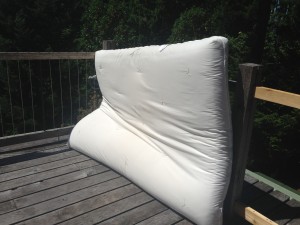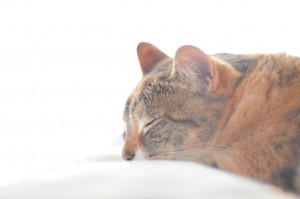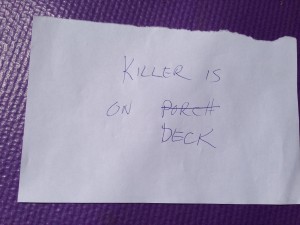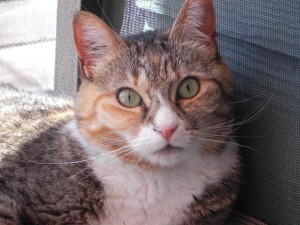KILLER IS ON DECK
We awoke this morning to find a scrawled note stuffed under the gate that separates the upper from the lower floors of our summer house. An advance warning, it read: “KILLER IS ON DECK”.
I’M PISSED
I’m sure there are plenty of people out there who would say I was crazy, but I spent the last couple of days dealing with the fallout of one of my cats, Zu, having pissed on the futon sofa at our cottage. Usually (here and at home) it’s on one of the beds. This is not something she does often, but often enough that we have resigned ourselves to covering the beds with a plastic sheet after they are made in the mornings. I have washed enough duvets and mattress covers to last two lifetimes! This new challenge was far worse. When I discovered her “faux pas” I groaned. Would we even be able to save it?
 After an initial spray and scrub in the evening, the next day I peeled off the futon’s cotton cover and put it through the wash, then dragged the futon out onto the deck. After some discussion about which cleaners might be most effective, my sister suggested using her new steam cleaner. I thought this was a brilliant idea, as the hot steam would hopefully sterilize, deodorize and annihilate the residual cat piss that had soaked into the fluffy cotton filling. Well, that was the theory, anyway.
After an initial spray and scrub in the evening, the next day I peeled off the futon’s cotton cover and put it through the wash, then dragged the futon out onto the deck. After some discussion about which cleaners might be most effective, my sister suggested using her new steam cleaner. I thought this was a brilliant idea, as the hot steam would hopefully sterilize, deodorize and annihilate the residual cat piss that had soaked into the fluffy cotton filling. Well, that was the theory, anyway.
I steamed that spot for quite a long while, until all I could smell was clean wet cotton, and then left the futon to dry in the hot, hot sun all afternoon. Unfortunately, though it dried quickly, I felt I could still discern a slight odor. Very slight. Maybe it’s just in my head. But, rather than write off the futon, we replaced the clean cover and put it on upside down, so as to avoid a repeat performance if she detected a familiar smell.

FELINE PSYCHOLOGY
Not that that is what motivates her. You see, she’s just a little temperamental. Certain things seem to upset her. Sometimes it’s the presence of a strange cat, which there has been a lot of lately. In the first instance, we are sharing the house with family, and although they have separate ‘zones’ our cats and their cousins are aware of each other and have occasional tense encounters. Secondly, there is a neighbour cat with some boundary issues, who insists on climbing the wisteria trellis and invading our house. She just seems to want to visit, but she’s surprisingly stubborn when we chase her away, and returns with fair frequency. If we use any of the usual “feline territorial” behaviors to scare her away, such as hissing, she turns and attacks quite aggressively. Thus her nickname: “Killer Cat” (ref. above note).
But what set Zu off this time was the arrival of my husband, whom she adores, who came to join us for the week. She got fairly excited, one would deduce. She has “issues” with suitcases, and “comings and goings.” These seem to be what sets her off the most, as we’ve had episodes before and after family holidays and business trips in the past. The rest of the time, she’s a lovely, affectionate, mellow cat, who is fairly needy as far as attention goes. She wakes us in the morning with a paw on the face, harasses us playfully if we oversleep, talks a blue streak through the day just to let us know what she’s thinking, and is always game for a hug and a kiss. Okay, a bit of a Prima Donna, really. But she loves us (we have proof!) And we all love her and her sister dearly. We would never for a moment consider getting rid of her.
A LIFETIME COMMITMENT
And yet I know there are plenty of people out there who wouldn’t hesitate to do so. Therefore, there are hundreds and thousands of abandoned pets in our communities, large numbers of whom have to be put down regularly because of abuse or space shortages, often for no greater crime than that they became an inconvenience for their humans. (Speaking of Prima Donnas) And trust me when I say that having a cat pee on your bed is INCONVENIENT. Still. She’s family. When I adopt an animal and bring it home, that’s it. I’m committed for life, no matter what happens. For richer for poorer, in sickness and in health, etc. etc. ’til death do us part. It breaks my heart to see those animals with no homes, no families and no hope. I want to adopt them all, but of course, we’ve got our hands full.
And I just want to point out that as a designer and an artist, I’m not immune to the appeal of a beautifully appointed home. I love good design, excellent craftsmanship and a well-appointed room as well as the next person. This is one of those things that I’ve just decided to accept. I chalk it up to the virtue “Renunciation” (See my previous post: Living with Chronic Pain). Although I think it’s supposed to refer to renunciation of sensuality, I toss everything to do with the material world into this same basket.
I adopted my first cat when I was just four years old. My sister (the same one) was walking me home from the local playground, down a little lane. And there, on a humble lean-to, was a sign that said “Free Kittens.” Inside, on a bed of hay, was a mother cat and her litter. A short time later we were heading home, a new black and white pibald kitten tucked into my sister’s shirt. We named her Alexandra, after the street where we found her, beginning a lifelong tradition of naming cats after streets (except for Zu and her sister Patches, but we had a 3-year old then) and a lifelong love affair with cats.
IRREPLACEABLE COMPANIONS

I cannot imagine a house without a cat. It just wouldn’t be a home. I’ve always had at least one through most of my life, and find that I enjoy their company often more than humans. My cats greet me, delight me and make me feel loved and important no matter what else is happening in my life. They understand intuitively what I need. They entertain me when I’m bored or lonely, comfort me when I’m ill or stressed, console me when I’m sad. They understand, and they know just how to be there and exactly what to offer to make everything better. And it’s not just your imagination. There is now scientific evidence that shows that cats are good for your health. You’d be hard pressed to say that about most people. Or furniture. So, I’ll take the bad with the good. It’s an easy trade-off in my world.



